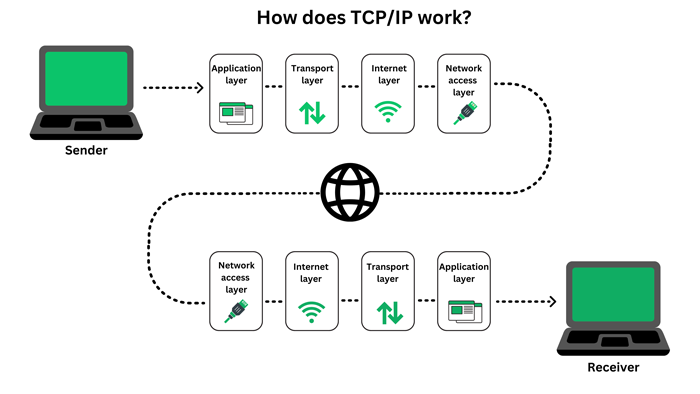Introduction to TCP/IP: The Internet's Communication Backbone
Understanding TCP/IP: The Core of Digital Communication
Internet Protocols: The Invisible Rules of the Digital World
Introduction to Network Protocols
Imagine you're writing a letter to a friend. You carefully address the envelope, ensure your message is clear, and drop it into the mailbox. Behind the scenes, there are countless rules—postal codes, delivery routes, sorting centers—that ensure your letter reaches its destination.
These rules are analogous to network protocols in the digital world. Without them, data would be lost, jumbled, or delayed in cyberspace. But what exactly are these protocols, and why do they matter?
Network protocols are the agreed-upon standards and rules that allow devices to communicate and share data reliably. Whether you're streaming a video, sending an email, or browsing the web, protocols ensure your data travels smoothly and securely from one device to another. They act as digital translators and traffic controllers, maintaining order amidst the chaos of global internet traffic.
The Role of Protocols in Data Integrity and Reliability
Picture a symphony orchestra. Each musician follows a conductor’s cues to create harmony. Similarly, network protocols coordinate how data packets move through networks.
They ensure:
Data Integrity: Information arrives without errors or corruption.
Reliability: Missing or out-of-order data is detected and corrected.
Efficiency: Data flows smoothly without bottlenecks or unnecessary delays.
Now, let's dive into the key protocols that make this possible: TCP/IP and UDP.
TCP/IP: The Backbone of the Internet
What is TCP/IP, and Why is it Fundamental?
TCP/IP (Transmission Control Protocol/Internet Protocol) is the foundational language of the internet.

Think of it as the postal service for digital data. While IP is responsible for addressing and routing packets to their destination, TCP ensures that the packets arrive intact and in the correct order. Together, they form a reliable system for data transmission, much like a courier who guarantees delivery and provides a tracking number.
TCP: The Careful Courier
TCP handles data transmission with the meticulous care of a librarian sorting books.
Here's how it works:
Data Segmentation: TCP breaks large data into smaller, manageable packets.
Error Checking: It checks for errors in transmission and requests retransmission if needed.
Acknowledgments: TCP requires the receiver to confirm receipt of data, ensuring nothing gets lost.

Key Concepts
IP Addressing: Each device has a unique address, like a house number, ensuring data reaches the right place.
Port Numbers: These act as specific doors within a house, directing data to the correct application (e.g., web browsers or email clients).
Datagram Transmission: Data is sent in packets called datagrams, which TCP organizes and verifies.
The 4 Layers of TCP/IP
Application Layer: Handles protocols like HTTP, FTP, and SMTP to support user applications.
Transport Layer: Manages communication between devices, ensuring reliability.
Network Layer: Routes packets across networks, connecting independent systems.
Link Layer: Operates at the physical level, ensuring data transmission between devices.
UDP: The Speedy Messenger
What is UDP, and How Does it Differ from TCP?
While TCP is the careful courier, UDP (User Datagram Protocol) is the speedy messenger who prioritizes speed over reliability. It’s perfect for scenarios where real-time performance matters more than error correction, such as live video streaming or online gaming.
When and Why is UDP Used?
Imagine a live sports broadcast. A brief video glitch is acceptable compared to a delay in the feed.
Similarly, UDP is used when:
Speed is critical: Delays can ruin user experiences, as in gaming or video calls.
Data loss is tolerable: Minor losses don’t disrupt the overall experience.
Comparison of TCP and UDP
| Aspect | TCP | UDP |
| Reliability | High (error-checking, retransmissions) | Low (no retransmissions) |
| Speed | Slower (acknowledgments add overhead) | Faster (minimal overhead) |
| Use Cases | File transfers, emails, web browsing | Gaming, video streaming |
Key Concepts
Datagram-based Transmission: Unlike TCP, UDP sends datagrams without establishing a connection.
Low Overhead: UDP skips error-checking to maximize speed.
Connectionless Communication: There’s no handshake or acknowledgment, making UDP lightweight and fast.
Comparison: TCP/IP vs. OSI Model
While the OSI (Open Systems Interconnection) model provides a theoretical framework with seven layers, TCP/IP offers a more practical, four-layered approach. Both serve as blueprints for network communication, but TCP/IP’s simplicity and efficiency make it the preferred choice in real-world applications.

Key Difference: The OSI model is a guide; TCP/IP is the standard.
Conclusion
Network protocols like TCP/IP and UDP are the unsung heroes of our digital lives. They ensure that your video streams smoothly, your emails arrive on time, and your online games remain immersive. By understanding these protocols, we gain insight into the intricate mechanisms that power the internet—an ever-evolving symphony of communication and innovation.
